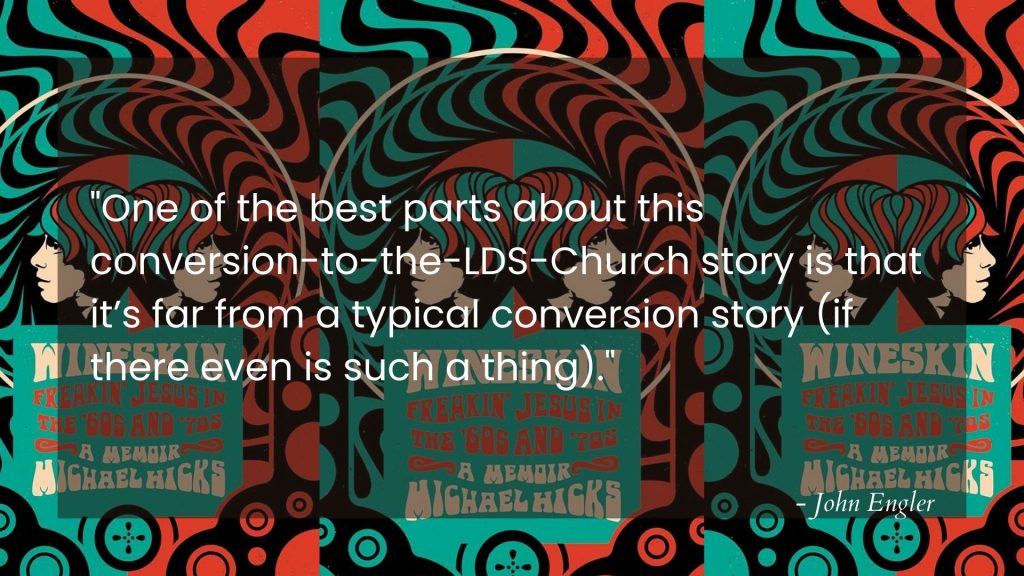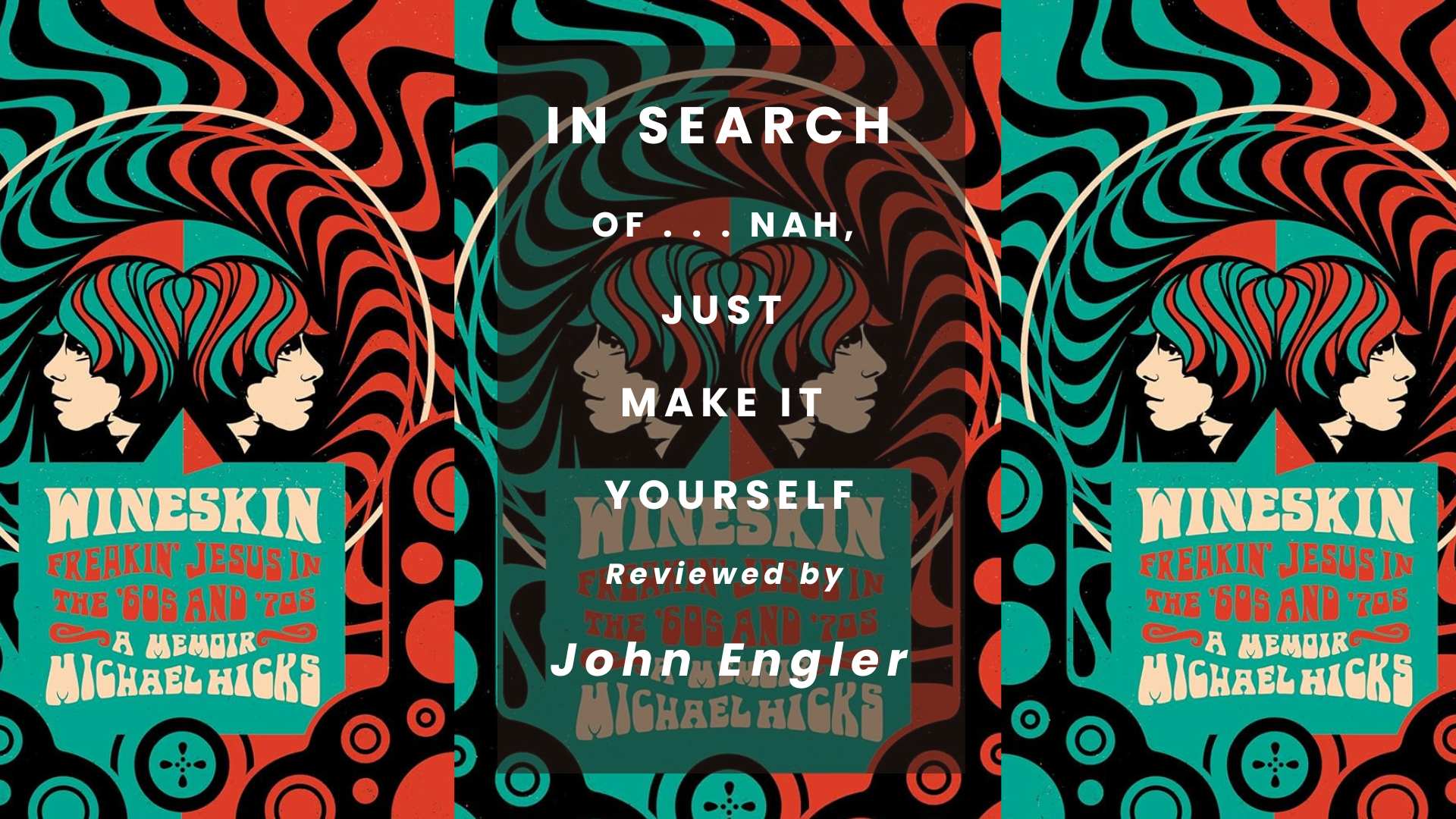Articles/Essays – Volume 57, No. 2
In Search of . . . Nah, Just Make It Yourself | Michael Hicks, Wineskin: Freakin’ Jesusin the 60s and 70s, A Memoir
From the minute I saw the title, I wanted to like this book. And when I got the book in my hands and saw the cover art, my 1960s nostalgia and Spidey-senses kicked into high gear, and I couldn’t wait to crack it open. If you’re wondering whether the book delivered, here’s the thumbnail sketch. Likeable narrator? Check. Nostalgia? Check. Unexpected twists and turns? Check. The book delivered all of it, and then some.
One of the best parts about this conversion-to-the-LDS-Church story is that it’s far from a typical conversion story (if there even is such a thing). I promise you that you will not see what’s coming. Partway through, there’s a great big twist, a big turn, and it blindsided me. It’s one of the things I love about great stories. Now, part of me wants desperately to talk all about the unexpected twist—it needs to be talked about by somebody at some point—but it’s just too early in the book’s lifespan. I don’t dare rob anyone of the experience of discovering it themselves. I may have said too much already.
There’s an off chance that I encountered Michael Hicks, a professor of music, in the Harris Fine Arts Center in 1988 when I was a student in music classes at Brigham Young University. But even if I had, there’s no way I could have guessed that this was his narrative. This story needed to be told. It’s a humdinger.
But it’s not just the major twist and turn and the resulting ripples that makes the story worth telling—it’s the persona of Hicks himself. Hicks is a true renaissance man, and it’s his one-man-band charisma that carries the narrative. He’s got a skill set that is as unexpected as his story and as broad as the 1960s cultural revolution. Hicks is, by nature, a producer of things. Compared with the youth of today who seem to be primarily consumers of digital content on digital devices, Hicks lives in an analog time and place where conspicuous consumption is not much of an option, although he devours the analog books and music of the day.
But the narrative leans into the producing and creating and designing a make-your-own-adventure kind of life. In the book, Hicks not only plays the piano and the guitar, he sings in casual and formal choir settings, writes songs (even entire orchestral scores), acts in theatre productions, and produces a variety of artwork in a variety of styles and mediums. All this artistic production peppers his story. Even lists of the books he reads show up, and as a reader, he’s no slouch. And he writes—not only this book, but lengthy articles and treatises and letters, some of which he shares in their entirety.
Hicks was a man born in his time. If he had grown up in the 1990s or the 2000s, this story could not have happened. Much of the story depends on the intersection of the character of Michael Hicks and the 1960s and 1970s countercultural zeitgeist. There’s no story without that intersection, in part because Hicks runs pell-mell into the counterculture, sometimes intentionally and other times unwittingly. But it also works because his experiences, although boundary-pushing, are so analog. Everything about Hicks’s experience depends on functions of his physical world encountering the metaphysical or spiritual world, but always through inherently grounded and analog functions. And it all happens in this delightfully nostalgic life-size shoebox diorama delivered in book form.
It’s probably fair to say that this memoir had some soft spots, too. Two in particular I’ll mention. For one, the throughline of the plot is a little loose. Especially early on, there was a fair bit of arbitrary reminiscing, which is lovely enough but does not necessarily drive the narrative forward. Later it makes more sense, but in the moment, I felt my attention drifting, and I actually set down the book without regret for several weeks.

With a bit of shaping from a stronger editor’s hand recommending, for example, an in medias res approach, the narrative could have have picked up steam right from the outset. On the other hand, if the intent was to re-create the aimlessness of youth in the 1960s, it may have succeeded on that count. Fortunately for Hicks, the creative inventiveness of his personality helps carry the less compelling sections of the narrative until readers reach the really riveting parts where the pace, purpose, and interest of the narrative pick up through to the end.
Second, there’s a lot of “telling” in this narrative. There’s a reason for the old adage—show, don’t tell—and the lack of scene building here plagues the story on a pretty regular basis. I mean I get it—it’s hard to go back to thin, decades-old memories and recall enough specifics to paint them accurately. Every memoirist faces this. Hicks essentially falls prey to the trappings of how he might orally tell the story instead of using the tools of written storytelling to create scenes with entrancing sensory detail, memorable character descriptions, and compelling dialog. That’s not to say there are none of those things in the book—there are. But those passages are generally brief and fairly rare, at least for my liking.
Instead, Hicks leans heavily toward summary, often omitting the sensory detail that help readers experience the moment themselves. The “telling” keeps readers at a distance and blunts the full power of a well-written scene. A few more drafts with an eye toward scene building would have gone a long way.
In addition, Hicks as narrator often surfaces in this narrative. Here’s an example: “Through the next two years, I watched many of my friends . . .” Here we see Hicks watching his friends instead of readers seeing his friends directly. This might seem like a negligible difference, but the insertion of the narrator as a filter between the reader and the scene, unfortunately, blunts great moments. There are such great scenes to be had here, but readers are going to have to do just a little more work themselves to fully appreciate them.
Make no mistake—this is a roller coaster of a read. One of the most important and lovely driving forces in the narrative is Hicks’s desire for meaningful community. He’s continually looking for ways to connect to other people, gather them, nurture them, and create music and community and meaning with them—with them and with God. And it’s this exact driving force that results in some of the most beautiful tender moments of the book—his creation of Wineskin, a community coffeeshop/free-spirit church, for example—as well as some of the story’s most unfortunate, heartbreaking turns. Through (nearly) it all, Hicks remains the eternal optimist, and seeing the way he manages to resurface and reclaim his place in the community of his making is a testament to his strength and fortitude. This book is his way, I suspect, of drawing yet more of us into his nurturing, freakin’ Jesus-inspired community. It sure seems enough to inspire and nurture nearly anyone.
Michael Hicks. Wineskin: Freakin’ Jesus in the 60s and 70s, A Memoir. Salt Lake City: Signature Books, 2022. 223 pp. Paper: $19.95. ISBN: 978-1-56085-453-1.


 Back to full Issue
Back to full Issue

